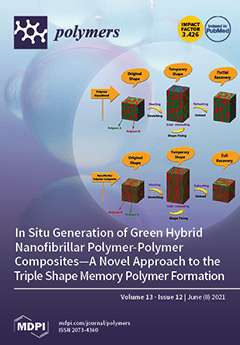The main objective of this work was to evaluate pulp produced by kraft cooking for wood materials (WMT) (
Bougainvillea spectabilis,
Ficus altissima, and
F. elastica) and non-wood materials (NWMT) (
Sorghum bicolor and
Zea mays stalks) and to study the fungal activity of handsheets treated with
Melia azedarach heartwood extract (MAHE) solutions. Through the aforementioned analyses, the ideal cooking conditions were determined for each raw material based on the lignin percentage present. After cooking, pulp showed a decrease in the Kappa number produced from WMT, ranging from 16 to 17. This was in contrast with NWMT, which had Kappa numbers ranging from 31 to 35. A difference in the optical properties of the pulp produced from WMT was also observed (18 to 29%) compared with pulp produced from NWMT (32.66 to 35.35%). As for the evaluation of the mechanical properties, the tensile index of the pulp ranged from 30.5 to 40 N·m/g for WMT and from 44.33 to 47.43 N·m/g for NWMT; the tear index ranged from 1.66 to 2.55 mN·m
2/g for WMT and from 4.75 to 5.87 mN·m
2/g for NWMT; and the burst index ranged from 2.35 to 2.85 kPa·m
2/g for WMT and from 3.92 to 4.76 kPa·m
2/g for NWMT. Finally, the double fold number was 3 compared with that of pulp produced from pulp, which showed good values ranging from 36 to 55. In the SEM examination, sheets produced from treated handsheets with extract from MAHE showed no growth of
Aspergillus fumigatus over paper discs manufactured from
B. speclabilis pulp wood. Pulp paper produced from
Z. mays and
S. bicolor stalks was treated with 1% MAHE, while pulp paper from
F. elastica was treated with 0.50% and 1% MAHE. With the addition of 0.5 or 1% MAHE,
Fusarium culmorum showed no increase in growth over the paper manufactured from
B. speclabilis,
F. altissima,
F. elastica and
Zea mays pulps with visual inhibition zones found. There was almost no growth of
S. solani in paper discs manufactured from pulps treated with 1% MAHE. This is probably due to the phytochemical compounds present in the extract. The HPLC analysis of MAHE identified
p-hydroxybenzoic acid, caffeine, rutin, chlorogenic acid, benzoic acid, quinol, and quercetin as the main compounds, and these were present in concentrations of 3966.88, 1032.67, 834.13, 767.81, 660.64, 594.86, and 460.36 mg/Kg extract, respectively. Additionally, due to the importance of making paper from agricultural waste (stalks of
S. bicolor and
Z. mays), the development of sorghum and corn with high biomass is suggested.
Full article






